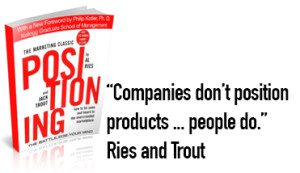Use Media Monitoring to Know Your Market Position
One of the basic rules of branding is built on the principle of positioning, and media monitoring can go a long way in helping you understand your market position. I’ve talked about positioning in past blog posts, and for other related links, see the end of this blog. The key principle regarding positioning that most companies and brand marketers get wrong is where the central point of influence in a brand or product’s position is. How many meetings have you been in where someone says, “We need to position this new product as … [fill in the blank with your favorite buzz-worthy promise here].
The problem with this thinking centers around the principle that companies don’t position products and services, people do. In other words, what the market — in aggregate — says about your product or service is your position, not what your marketing team or communications efforts say it is.
So that begs the question: how do we know what the market — in aggregate — says about or thinks about our product or brand? Glad you asked! Because I’m going to spend the rest of this blog post giving you tips on how to figure this puzzle out, with relative ease and at little to no cost.
The key trick to knowing what the market is saying about your product or service is based on good old-fashioned market research, and the good news is that with many of the online digital tools and services available today, it’s easier, and more efficient than ever to monitor the world wide web for words, topics, names … anything … that matters the most to you.
There is a wide range of tools available to do monitoring, and I’m not going to cover all of them in this blog post. See this link for a reference to some of the tools — both free and paid — available for online monitoring.
While the tool you use can make a big difference in the effectiveness of your monitoring efforts, the most important step is deciding what you are going to monitor. And that strategic decision starts with a high-level structural view of the categories or classes of keywords you want to monitor.
I’m going to recommend those categories be Brand, People, Campaigns, Sector and Pages. I’ll go into a little detail on each below.
Media Monitoring – Brand
It seems obvious that a company would track online mentions of its own brand, but in my experience with companies big and small over thirty plus years is that this is often not the case. Even before the Google’s of the world brought real-time search and monitoring to the marketing environment, companies had access to clip services, which did that – manually read through thousands of magazines, newspapers, journals, etc. monthly looking for keywords buried in stories or feature articles. Today, that process is so automated and fast in the online world, it’s essentially a must-do if you are to stay aware of how your brand is being talked about online. And remember, the places where your brand is being talked about are the places impacting your company’s position. So, step one, add your brand name to the list of keywords that you are tracking.
By the way, since your position is essentially what the market in aggregate says about you — versus your competitors — you need to be monitoring mentions of competitive brands as well. Especially take note of any mentions that appear which include your brand along with your competitive brand (sometimes referred to as “roundup†coverage). Especially if it’s an influential outlet or website with lots of visitors, this third-party coverage could have a significant impact on your overall positioning.
Media Monitoring – People

Okay, let’s give a handful of companies props for taking the first steps into monitoring and keeping track of online brand mentions. But that’s no reason to stop there — especially if your monitoring service gives you the ability to track multiple keywords at once (which almost all do … free and paid tools included).
Going back to the principle of positioning which says that companies don’t position products, people do, it only makes sense that you would also track comments from key people in your brand circle of influence. This could be a wide range of people, from your CEO (or anyone in the C-Suite), Director of Marketing or even someone in HR (who might be quoted in an article on tips that top companies are looking for in when hiring). Or, a spokesperson for a competitive brand or product who may be quoted in an article.
Also, another key step (but admittedly one that doesn’t apply to every company) is to track any comments from your designated key spokesperson or spokespeople. Particularly in sectors where endorsees are key influences (such as in athletic shoe marketing or musical instruments), tracking those names can help you discover if your key brand messaging points are being conveyed through your influencer marketing efforts, and whether the dollars you are putting to influencer marketing are helping or hurting your efforts.
I’ve personally been involved in situations where our marketing team realized that a brand ambassador or influencer was straying off of or diluting, key messaging points in interviews, and since your agreements with these spokespersons should include some sort of messaging training and preparation, it’s better to nip this in the bud sooner than later.
Media Monitoring – Campaigns
The word “campaigns†has become commonplace across digital media boundaries. Historically, it referred to paid advertising programs. And that is largely still the case — most campaigns fit in the “Paid†category, and Facebook has even gone as far as designating the “Campaign†as the highest level of setup and management in the Facebook marketing and re-marketing arena.
Tracking paid campaigns such as Facebook marketing and Google Adwords is a bit beyond the scope of this post on organic tracking, but for more on the steps in tracking paid campaigns, see this blog post on Facebook analytics.
One new trend in the approach to campaign tracking is keeping tabs on editorial campaigns. Centered around what I call a Content Distribution Ecosystem, a series of connected editorial elements are crafted around a singular message or key communication point and tactically distributed, i.e. within a close window of each other for maximum impact.
These elements can include a wide range of owned content pieces, from press releases, to blog posts, podcasts, video podcasts, infographics, email newsletters, online presentations and webinars and social media posts. For tracking, use a tool like Bit.ly to create custom URLs for the placed components such as blog posts, press releases. You can track activity via the Bit.ly link to gauge ROI.
Audio and video podcast downloads can be tracked a number of ways (including using Bit.ly links). Using a service such as Libsyn, you can track downloads of an audio podcast, time engaged per listening session, etc. Soundcloud offers another free way to host audio podcasts and track activity.
Video podcasts can be tracked using a service like YouTube, or for really robust metrics — such as time viewed, most popular sections, etc, use a service like Wistia (note: Wistia is a paid service but has a very basic free trial that you can use to track up to three videos.
And for landing pages and email newsletters, use a service like Leadpages to track landing page views and conversions and Drip! to build automated email campaigns that can be tracked over time to keep interest levels high in your original content.
Media Monitoring – Sector
Using your media monitoring service, don’t forget to track the generic terms for your industry or sector. When it comes to understanding patterns and positioning shifts, its best done in the context of the overall market. So, if you marketing a revolutionary new portable bicycle pump targeting mountain bike enthusiasts, monitor trends in the mountain biking sector to see what consistent themes are popping up.
The great thing about many of the media monitoring services is that they also crawl user forums, so when there is a relevant mention of your brand, product or industry sector in one of these grassroots forums, you’ll be able to pick up on the thread and glean real-world insight as to what your specific target is saying, feeling or planning to do in your market sector.
Media Monitoring – Pages
Finally, when it comes to analyzing how all of the content is working together. there is no greater tool than Google Analytics. This is especially true if, like most online content marketing programs, the ultimate goal is to build or raise awareness, and assuming you’ve put time into designing your website for this purpose, ultimately any and all interested parties are going to go to your home URL.
So having Google Analytics tracking capabilities on your site is a must if you want to get a macro view of how your content campaigns are impacting your high-level strategic goals.
Conclusion
To wrap it up, monitoring and measuring success in content marketing today is not only easier than its ever been thanks to a wide range of tools, but it’s pretty much become a standard baseline practice when it comes to digital marketing. This is because the web, as an intensely dynamic publishing platform, shifts quickly based on consumer habits and input. Having the ability to measure and monitor that activity, and respond to it, in real time is essential in creating a successful content marketing program today.
Resources:
To Set Your Heading, Get Your Position
Positioning: Winning The Battle of the Mind

Bill Threlkeld is president of Threlkeld Communications, a content digital marketing and public relations advisory based in Santa Monica, California. Threlkeld Communications specializes in content ecosystem campaigns, also known as the Content Distribution Ecosystem, a unique content approach that synchronizes and integrates PR, Social Media, Blogs, Audio, Video, Email Marketing and other content marketing components for systematic distribution and measurable results.
